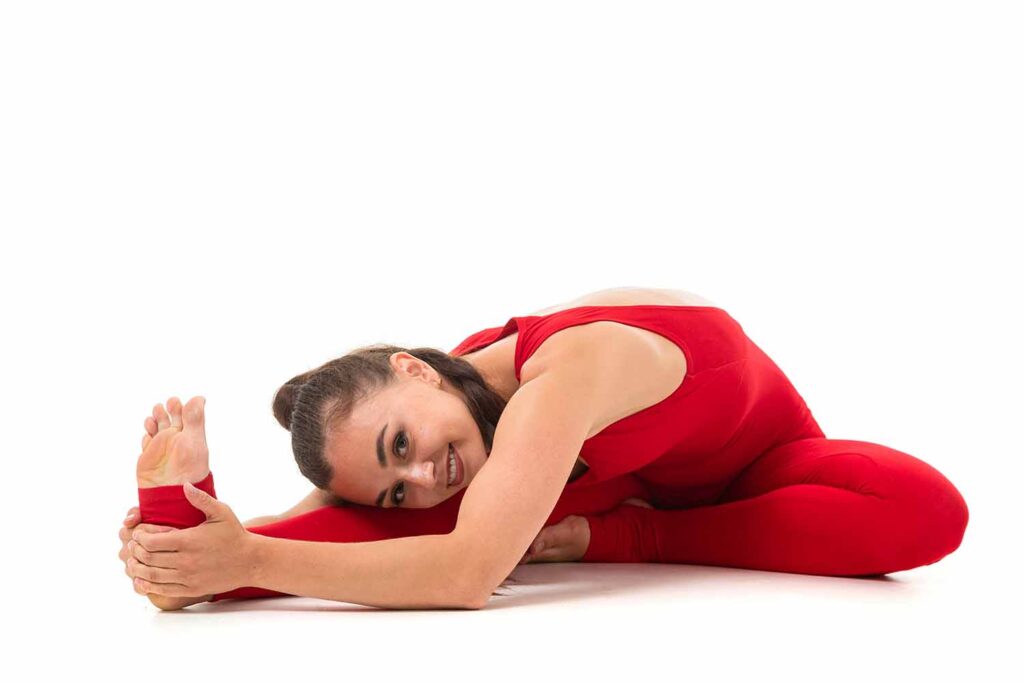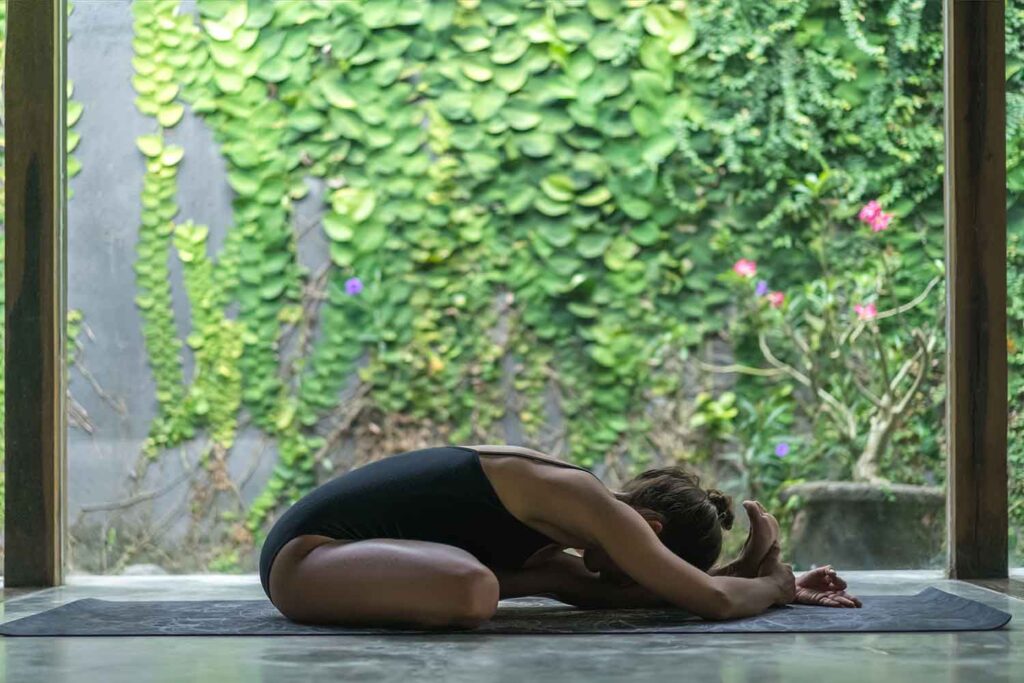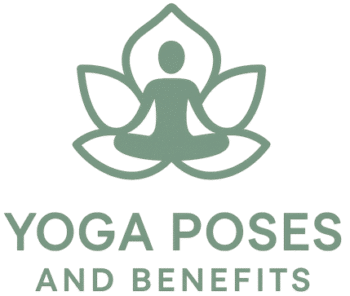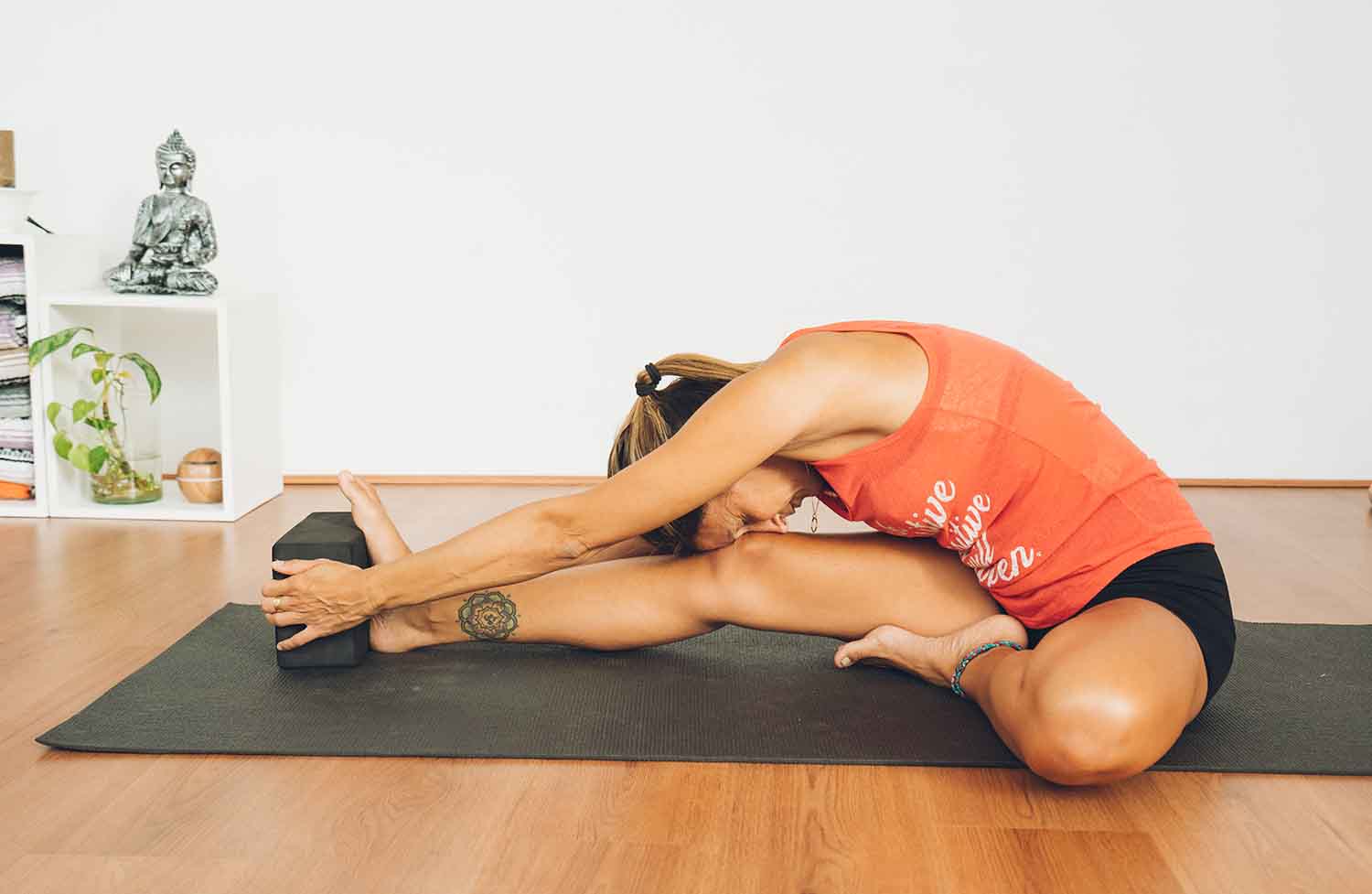Head-to-Knee Forward Bend Pose in yoga (Janu Sirsasana) is a calming seated posture that stretches the hamstrings, lower back, and shoulders while encouraging introspection and relaxation. It is often used to release tension in the back and hamstrings and improve flexibility in the hips. This pose can be both restorative and deeply stretching, depending on the intensity of your fold.
Other Names for Head-to-Knee Forward Bend Pose
- Janu Sirsasana
- Head-to-Knee Pose
- Seated Forward Bend with One Leg
How to Do Head-to-Knee Forward Bend Pose in Yoga
Follow these steps to practice Janu Sirsasana effectively:
- Begin seated in Staff Pose (Dandasana), with your legs extended forward and your spine long.
- Bend your right knee and bring the sole of your right foot to the inner left thigh, allowing the knee to open outward. Ensure both sitting bones remain grounded.
- Inhale deeply and reach your arms overhead, lengthening through the sides of your body.
- As you exhale, hinge forward from the hips, leading with your chest as you fold over your extended left leg. Keep the spine long as you lower your torso toward the leg.
- Place your hands on your shin, ankle, or the sole of your foot, depending on your flexibility. If needed, use a strap around the foot to maintain the length in your spine.
- Gaze softly toward your extended foot and relax your shoulders, allowing the fold to deepen with each breath.
- Hold the pose for several breaths, focusing on inhaling length and exhaling into the stretch.
- To release, inhale and slowly rise up with a long spine. Repeat the pose on the opposite side.
Variations of Head-to-Knee Forward Bend Pose
Exploring variations can help deepen your practice or provide more support:
- Supported Janu Sirsasana: Place a folded blanket or block under your bent knee for added comfort and support in the hips and lower back.
- Twisting Variation: After folding forward, reach your opposite hand to the outer edge of your extended foot, creating a gentle twist through your spine. This variation increases spinal mobility and stretches the back further.
- Restorative Version: Use a bolster or pillow on top of the extended leg to rest your torso, making the pose more restorative and accessible for relaxation.
Modifications for Head-to-Knee Forward Bend Pose
Consider these modifications to make the pose more accessible and comfortable:
- Use a Strap: If reaching the foot is difficult, loop a strap around the ball of your foot. This helps maintain a straight spine while gently easing into the fold.
- Bend the Knee: Slightly bend the knee of your extended leg if the hamstrings feel tight, ensuring you can still fold forward with length in your spine.
- Support the Knee: For added comfort, place a block or folded blanket beneath the bent knee to reduce pressure on the hip and support the joint.

Contraindications for Head-to-Knee Forward Bend Pose
Be mindful of these contraindications before practicing Janu Sirsasana:
- Hamstring Injuries: Avoid overstretching the extended leg if you have a hamstring injury. Consider bending the knee or keeping the fold shallow to prevent strain.
- Lower Back Pain: Those with lower back discomfort should focus on lengthening the spine and avoid rounding the back. Use props for support if needed.
- Knee Issues: If you experience discomfort in the bent knee, ensure the knee is supported by a block or blanket. Avoid deep flexion of the knee if it causes pain.
- Pregnancy: Pregnant practitioners, especially in the second or third trimester, should keep the torso lifted or use a bolster for support to prevent compression of the abdomen.
Tips to Improve Head-to-Knee Forward Bend Pose in Your Practice
Incorporate these tips to refine and deepen your practice of Janu Sirsasana:
- Engage the Thighs: Actively engage the quadriceps of your extended leg to protect the hamstring and prevent hyperextension of the knee.
- Hinge from the Hips: Focus on hinging from the hips rather than rounding the spine. Keep the back long, even if it means a more shallow fold.
- Use the Breath: With each inhale, lengthen your spine, and on each exhale, gently fold deeper. Let the breath guide your movement into the stretch.
- Keep the Neck Soft: Avoid tensing the neck or head. Keep the gaze soft and relaxed to allow the upper body to fold naturally.
- Activate the Core: Engage your core muscles to support the lower back and maintain stability as you deepen the fold.
What Muscles Does Head-to-Knee Forward Bend Pose Work?
Janu Sirsasana stretches and strengthens several key muscle groups:
- Hamstrings: The extended leg’s hamstrings are deeply stretched in the forward fold, enhancing flexibility in the back of the thigh.
- Calves: The muscles of the lower leg, particularly the calf, are engaged as the foot flexes toward the shin.
- Lower Back (Erector Spinae): The muscles along the spine stretch as the back lengthens into the forward fold.
- Hip Flexors: The bent leg encourages an opening in the hip flexors and inner thigh, promoting flexibility in the hips.
- Shoulders: As you reach forward, the shoulders experience a gentle stretch, relieving tension in the upper back and shoulders.

Mental and Emotional Benefits of Head-to-Knee Forward Bend Pose
This pose not only offers physical benefits but also supports mental and emotional well-being:
- Calming the Mind: As a seated forward fold, Janu Sirsasana encourages introspection and soothes the nervous system, helping to relieve stress and anxiety.
- Fostering Patience: The slower pace of this pose teaches patience, encouraging a mindful approach to both the breath and body.
- Promoting Relaxation: Deep, controlled breathing in this posture fosters a sense of inner calm, promoting relaxation throughout the body and mind.
- Enhancing Focus: Focusing on alignment and breath during this pose helps cultivate mental clarity and concentration, enhancing mindfulness in your practice.
Is Head-to-Knee Forward Bend Pose Suitable for Beginners?
Yes, Janu Sirsasana is suitable for beginners, especially with modifications:
- Use Props: Beginners can use a strap around the foot and blocks under the bent knee for support, making the pose more accessible.
- Keep the Fold Gentle: Focus on maintaining a long spine rather than forcing a deep forward bend. A more gradual approach to flexibility will prevent injury and promote proper alignment.
- Practice Patience: Encourage beginners to focus on breath and alignment, rather than the depth of the pose, allowing them to slowly increase flexibility over time.
Is Head-to-Knee Forward Bend Pose Suitable for Advanced Practitioners?
Advanced practitioners can deepen their experience of Janu Sirsasana by incorporating more challenging variations and refining their alignment:
- Deeper Fold: Work toward fully lengthening the spine and reaching the chin or forehead toward the extended leg, provided the back remains flat and the hamstrings are well-prepared.
- Twisting Variation: Incorporate a twist by reaching the opposite hand to the outer edge of the foot or shin, intensifying the stretch across the back and shoulders.
- Arm Bind: For added intensity, advanced practitioners can reach the hands behind their back and clasp the wrist of the opposite hand, deepening the stretch through the arms and shoulders.
- Activate the Bandhas: Engaging Mula Bandha (root lock) and Uddiyana Bandha (abdominal lock) during the pose will enhance core engagement and stability.
How Does Head-to-Knee Forward Bend Pose Contribute to a Yoga Sequence?
Janu Sirsasana fits well into many different types of yoga sequences, providing both preparatory and counter-stretch benefits:
- Hamstring Opener: This pose serves as an excellent hamstring stretch before more intense forward bends or seated postures.
- Transition to Seated Poses: Use this pose to transition between standing and seated sequences, allowing the body to shift into deeper flexibility.
- Counterpose to Backbends: Janu Sirsasana offers a gentle counterbalance to deep backbends, helping to stretch the back and promote spinal flexibility.
- Cooling Pose: As a calming forward fold, this pose works well toward the end of a practice to settle the mind and body before moving into savasana.
How Can I Deepen My Practice in Head-to-Knee Forward Bend Pose?
To advance your practice of Janu Sirsasana, focus on these techniques:
- Warm Up Properly: Prepare your hamstrings and lower back with preparatory poses like Downward Dog and Seated Forward Bend (Paschimottanasana) before attempting a deeper fold in Janu Sirsasana.
- Incorporate Twists: Add a gentle twist to your forward bend, reaching the opposite hand to the foot for a more intense stretch along the side of your body.
- Use Props Mindfully: Although advanced practitioners may be flexible, incorporating props like a strap or block can still provide extra support, allowing for longer holds and deeper stretches.
- Focus on Core Engagement: Keep the core engaged as you fold forward, supporting the lower back and protecting against strain.
- Breathe Deeply: Synchronize your breath with your movement, using the exhale to ease into the stretch and the inhale to lengthen the spine.
Common Mistakes in Teaching Head-to-Knee Forward Bend Pose
To ensure safe and effective practice, address these common mistakes:
- Rounding the Spine: Encourage students to focus on maintaining a long spine rather than rounding the back in an effort to reach the foot. Emphasize hinging at the hips.
- Forcing the Fold: Remind students to prioritize alignment over depth. It’s better to keep a gentle fold than to overstretch and risk injury.
- Neglecting the Bent Knee: Some students may allow the bent knee to lift or rotate inward. Guide them to keep the knee grounded and open, providing support if necessary.
- Lack of Core Engagement: Students may collapse into the pose without engaging the core. Teach them to activate their abdominals to protect the lower back.
By addressing these common errors, teachers can support students in developing a safe and mindful practice of Head-to-Knee Forward Bend Pose.
What are the benefits of head to knee forward bend pose?
The benefits of Head to Knee Forward Bend Pose, or Janu Sirsasana, include improved flexibility in the hamstrings, hips, and spine, as well as enhanced digestion and stress relief. Practiced in Hatha and Iyengar yoga styles, it also supports relaxation and mental focus through mindful breathing.
What muscles do the head to knee pose work?
The head to knee pose, also known as head to knee forward bend pose or Janu Sirsasana, primarily works the hamstrings, calves, and lower back muscles. It also stretches the spine and groin while gently engaging the hip flexors and abdominal muscles for support and stability.
How long to hold a forward fold?
A forward fold, such as the Head to Knee Forward Bend pose, is typically held for 30 seconds to 1 minute in yoga practice. Holding the stretch allows the hamstrings and lower back to release tension. Using props like yoga blocks can support alignment and deepen the pose safely.

